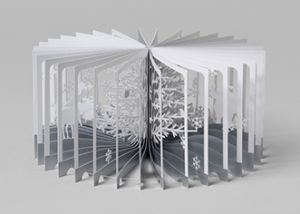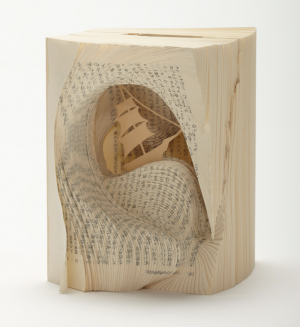Artist Books
Artist Books refers to a unique manifestation of the book as a medium. Unlike other books, like catalogs, that simply showcase art of another medium in a book, Artist Books are their own artistic medium.[1] These books attempt to question the very nature of books. The book is a rather illusive technology to define, but through their work, Artist Books attempt to raise important questions regarding what makes a book "a book."
Overview
Artist books are rather loosely tied to books, and yet their connection to books is crucial to understanding this genre of art. A book made by an artist that reads and functions just as a standard book would is not an "Artist Book." What makes an Artist Book an Artist book, is an experimental piece of art that calls upon one's notions of what a "book" is, either in form or purpose.[2]
At the heart of Artist Books as an artistic genre is not the specific practices involved or the connection to books (though that connection is fairly central), but rather the artist's intent.[2] Whether it's an exploration of abandoned bookmaking techniques, unique organizations of a book's material, or a presentation of a book that is literally unreadable for one reason or another, the questions or ideas an artist sets out to express through their work is crucial to the Artist Books genre.
History
Origins

Artist Books have a long history, dating back to the earliest iterations of the "book" in the 1400s when book makers experimented with various manufacturing practices.[2] However, the origin of this art form is typically attributed to the British artist and author, William Blake.[3] His work in the 1700's and 1800's created the foundation for the artistic genre known as Artist Books today. He developed a unique printing method that allowed him to incorporate intricate designs into his work, but his most notable contribution to the Artist Book genre was the motivation for his artistic practices. Creating, publishing, and distributing books are all very involved tasks, typically distributed among several organizations to delegate the various responsibilities. However, William Blake took on every aspect of the book production process for his books, asserting that he wanted complete control so he could be "independent of commercial publishers and letterpress printers."[3]
Further Developments
Most scholars agree that William Blake was the founder of the Artist Book genre. However, those who disagree typically point to Ambroise Vollard.[3] This art dealer, based out of Paris in the 1890's, laid the foundation for today's Artist Books, referred to in French as the "livre d'artiste."[3] While Vollard's work does not quite fit today's standards of what is considered an Artists Book (it still resembles conventional notions of what a book is more than it strays from it), his work was considerably notable at the time for focusing far more on the images in the book than any of the text.[3]
In the 1950s, book manufacturers experimented with various forms of binding and printing that included cuts and slits through various pages.[2] Ed Ruscha made some notable innovations in this time, producing books that were entirely composed of images, bringing the gallery/museum experience to a broader audience.[2]
Contemporary Examples
Carousel Book

The Carousel Book is a type of Artist Book, specifically a type of movable book.[4] Carousel books typically resemble the classic codex when closed. Only upon opening does the book reveal itself to be a 360˚ circle, usually featuring some sort of artistic display through the pages (often with cutouts). One notable example in the Smithsonian collection is Yusuke Oono's Snowy world: 360˚.[4]
Puzzle Book
Some Artist Books incorporate puzzles so as to more naturally prompt the exploration of the books "pages," however figurative that term may be. Artist Jody Williams' book For Now is an excellent example of one of these puzzle books. Jody's book serves as an exploration of the number four, featuring four boxes, on four accordion panels, each with a small vial of dust.[5] As is often the case for acclaimed Artist Books, Jody's work was praised for its poetic nature and "delightful" imagery.[5]
Sculpture Book

Lastly, Book Artists will sometimes play with the book form itself, sculpting it or manipulating it in a manner that changes it so much that it is no longer readable. Tomoko Takeda is an example of one of these artists.[6] Her works take classical texts and sculpt the physical books into scenes from the respective novels.
References
- ↑ What is an artists' book Printed Matter, Inc., Retrieved 2 Dec. 2020
- ↑ 2.0 2.1 2.2 2.3 2.4 Anne Evenhaugen What is an artists' book? Unbound Smithsonian Libraries, Retrieved 2 Dec. 2020
- ↑ 3.0 3.1 3.2 3.3 3.4 Book Art Resources: Brief History of Artists' Books Yale University Library, Retrieved 2 Dec. 2020
- ↑ 4.0 4.1 Elizabeth Broman A Carousel Holiday Decoration Unbound Smithsonian Libraries, Retrieved 2 Dec. 2020
- ↑ 5.0 5.1 Laurie Hertzel Jody Williams wins Minnesota Book Artist award Star Tribune, Retrieved 2 Dec. 2020
- ↑ Low Lai Chow Artist Remakes Famous Books Into Art Masterpieces boredpanda, Retrieved 2 Dec. 2020